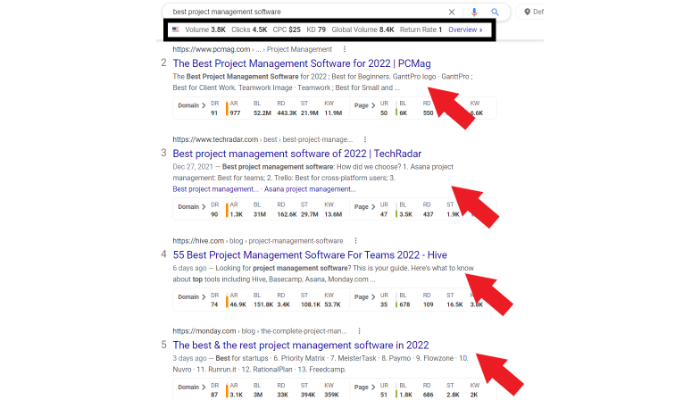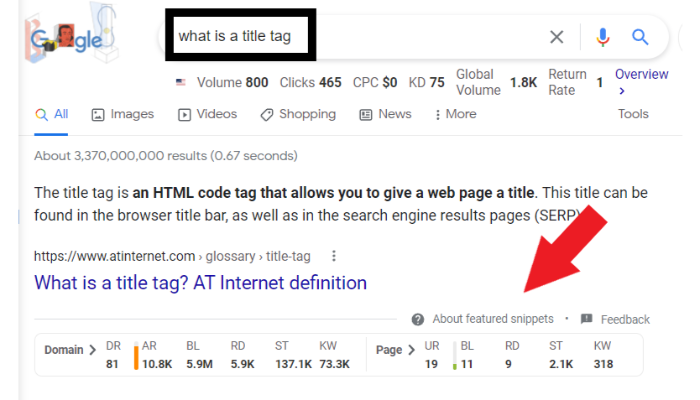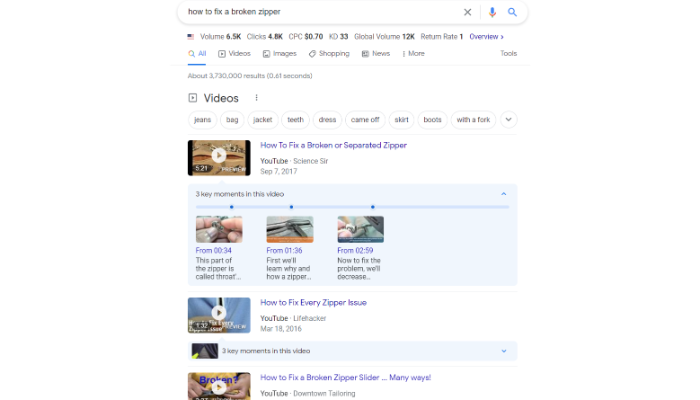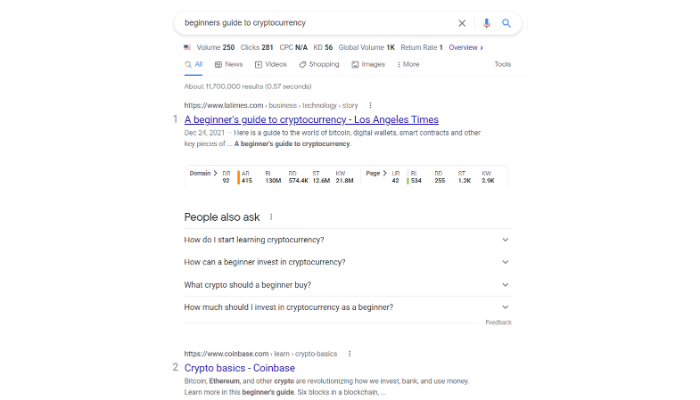
A 2021 survey found bloggers who publish 2-6 posts per week are most likely to achieve their goals.
Even though you probably know that posting more frequently gives you a better chance of success, it can be hard to come up with that many new blog topics.
You’re staring at the blank page. As it looks back, you begin wondering why you even started a blog.
This is the reality many bloggers face.
Coming up with new and interesting blog ideas is a serious challenge. The good news is finding great blogging ideas might not be as hard as you think.
This guide offers 25 new blog ideas to inspire you to write high-quality content consistently.
25 Blog Ideas for 2022
Writing is easy; coming up with ideas and conceptualizing them to make people want to read them is the real challenge. Here are some ideas to help you get started:
1. Review Products and Services
Eighty-nine percent of customers say they read reviews before making purchases. Capitalize on this by creating blog posts that review popular products and services related to your industry.
If you head over to Google right now and type in “best,” you’ll likely be greeted by a variety of products or services that complete the search query.
Best blender, best tackle box, best project management software, best HR management tool, and best Keurig K-cups are all popular Google searches. These are called review blog posts.
These blog posts provide a comprehensive breakdown of various goods and services. The goal is to write a better review than the current options on Google. You can do this by:
- providing more valuable content than the top-ranking posts
- having a better on-page experience than the top posts
- ensuring your post has SEO than the top posts
For example, Google, “best project management software.” There are tons of reviews from popular tech websites breaking down the best software. You’ll also see this keyword has pretty high search volume, with as many as 4,500 clicks per month.

You’d potentially outrank these sites if you wrote an article about the best project management software that is more comprehensive—and you’d generate traffic to your website.
Start by looking at the current top-ranking blogs. Note things like:
- how long they are
- what headings they use
- how many options they compare
Aim to make your post longer and more informative by covering more platforms, adding videos, even interviewing a few experts. The goal is to offer more value and slide into that top Google spot.
2. Break Down Complicated Processes Into Simple Steps
People turn to Google when they can’t figure something out. Think of how many times you’ve Googled how to cook a meal, unclog a tub, or use features in your favorite soft water platform. More than one billion Google searches per day are in the form of a question.
You could put together a guide explaining how to do something you’re interested in or knowledgeable about. The guide should outline all the steps the reader needs to accomplish whatever they’re trying to do.
Let’s use website loading speed as an example. This is a popular topic right now with core web vitals becoming more relevant.
Writing a blog post breaking down all the little things you can do to improve page speed makes the information easy to absorb and more actionable for readers.

Crazy Egg did a great job here by providing 20 ways to improve your website’s speed. When it’s broken down like this, it doesn’t seem like a huge task anymore. You could do each of these things one by one and gradually improve your page speed.
3. “Frequently Asked Question” (FAQ) Blog Posts
More than 14 percent of searches on Google are in the form of a question—if you can provide a comprehensive answer, you’ve got yourself a blog post idea.
The best part about writing an FAQ blog post is you have a good chance of getting the featured snippet section on Google if the article provides a lot of value to the reader.
If I search “what is a title tag” on Google, I get a lot of search results because this is a frequently asked question. At the top, you’ll find a result where Google took the answer from the blog post and put it right there for the reader.

This is called a featured snippet, and earning a featured snippet spot is considered the “crown jewel” of SEO. Many factors determine what site earns the snippets, but in this case, atinternet.com answers the question right away, which could be why they are at the top.
There are a few ways to find frequently asked questions:
- Do keyword research with a tool like Ubersuggest to determine frequently asked questions in your industry. Start by entering a generic keyword and find the long-tail questions that contain (or are associated with) that keyword.
- Do a manual google search and look at the questions that autopopulate in the SERPs under the heading “People Also Ask.”
- Use tools like Answer the Public to see what people are searching for in your industry.
- Search Quora for topics related to your industry to find common questions.
After you compile the list of questions, manually search them in Google. See whice posts have earned featured snippets, and take the time to write a better answer than the ones provided. You can do this by answering more concisely, with better formatting, or using more accurate definitions.
4. “Ultimate Guide” Blog Posts
One great way to build authority for your website is creating ultimate guides. These guides exhaustively break down every step necessary to complete a task.
Thorough content, like that contained in an ultimate guide, is becoming the norm. As of 2021, the average blog post was over 1,400 words; longer than ever in the past. The same study found content that is 3,000 words or more tends to perform better.
You’ll want to provide plenty of graphics, examples, and analogies to make sure the reader understands.
The main thing to remember about ultimate guides is they should offer everything from A to Z. When the reader leaves, they should have everything necessary to accomplish their goal.
Here is an example I did on local SEO.
This guide literally covers everything from “what is local SEO” to implementing it, steps to take, how to maximize your potential, and more. The guide is long, but it offers everything you need, so there’s no need to go anywhere else.
An amazing ultimate guide is a great way to show your readers and Google that you’re an authority on the subject.
To create an ultimate guide, start by searching your core keyword, then look for “people also ask” question boxes and answer those too.
You can also use my free tool Ubersuggest to find related keywords, which might provide ideas for headings in your ultimate guide post.
Add detailed information in your ultimate guide posts, like supporting statistics, process breakdowns, and examples.
5. Data-Driven Blog Posts
Backlinks are crucial for SEO – the URLs in the top position in the SERPs have an average of 3.8 times more backlinks than the URLs in positions 2 through 10.
When you’re looking for blog ideas or topics, you want to make sure your content is relevant and in demand. One way to do this is by blogging about data relevant to your niche.
What do I mean by this?
Great data is factual information found through experiments, tests, and surveys. The more eye-popping the data, the more attention you’ll generate.
Creating blog posts by compiling a lot of data into one article is a great way to earn backlinks. Whenever someone is looking for data to add to their article, they’ll find that information in your blog post and ideally link back to your site.
Take this article on 99 mind-blowing digital marketing statistics as an example. It’s essentially a giant list of data on social media, content marketing, SEO, and more. It’s a great resource for people looking to gather data on this subject.
If you have access to internal data or analytics, you can use that to create data-driven posts about industry trends.
Here’s how to create data-driven posts:
- Brainstorm questions you can answer with either data you have on hand, or have the resources to research (i.e. conducting a survey). Use tactics like utilizing keyword research tools, conducting manual searches,
- Carry out the analysis/survey.
- Write a post that explains your results.
- Be sure to include data visualizations!
6. Blog Posts With Tutorial Videos
As we all know, video is king. Ninety-seven percent of marketers use videos to help their customers better understand products and services. You should do the same.
There’s a reason why Google displays videos as the first result of many “how-to” queries.

If you look at the picture, I Googled “how to fix a broken zipper.” Naturally, Google displays videos first.
It’s a lot easier to watch a video than read a blog article. That doesn’t mean that blogging about it is useless, though.

If we scroll down to the first search result and check out the blog post, we find a tutorial video in addition to a blog post breaking down how to do it.
Including videos in your blog posts is a great way to provide more value to your readers and make Google happy.
Here’s how to get started creating videos for your blog:
- Dig into your analytics to identify your most popular content. Make a list of possible tutorial topics based on what you find. For example, if your top content is about blog post ideas, you may make a tutorial breaking down popular methods for brainstorming and identifying blog topics.
- If you still need ideas, use the same methods we suggested for finding frequently asked questions. Identify questions that relate to procesess, which you can showcase in tutorial videos.
- Record and edit your video using your chosen video technology.
- Include video transcripts for accessibilty and SEO.
7. Incorporate Trends Into Your Blog Posts
It’s no secret that trends come and go, but you can snag some decent traffic by writing about current trending topics in your industry.
The keyword “trends” paired with industry terms like “social media,” “marketing,” “hair color,” etc., account for millions of Google searches per month. This shows you have a great chance of capturing traffic if you cover trends in your industry in your blog posts.
Google Trends is a great way to figure out what’s hot and what’s not in the current climate.
Head over to trends.google.com and type in a topic you’re curious about or search currently trending searches.

At the time of writing this, a popular topic from Google Trends is New Orleans Saints coach Sean Payton retiring from the NFL. If you’re a sports blogger, you can do what Sportingnews.com did and write about the coach’s retirement.
Writing about trending topics will force you to be vigilant about what is happening in your industry, and you’ll have to be ready at any moment to research and gather the latest scoop if you plan to generate traffic to your blog.
Also, make sure to only write about trending topics your audience cares about. A women’s haircare site, for example, isn’t likely to get much traffic writing about a coach’s retirement (unless it’s a haircare site targeting sports fans!)
You can also use keyword research tools and plugin “trends” and see what topics come up related to your industry. Google searches with the year tacked on to the search query also receive a lot of searches. If you choose to do this, think about how the content will play into your strategy on evergreen content (for example, will you update the post under the same URL each year?)8. Industry News
Forty-one percent of blogs report on industry news. News blog posts might not be the greatest for SEO, but they generate a very loyal audience that hangs on your every word, and could indirectly boost your position in the SERPs.
This one is similar to the previous example, but there’s a core difference. Trending topics means sharing information your audience is likely to be interested in. With news, you share the news and offer up your thoughts and opinions.

Vox is an interesting example of this. Instead of just highlighting the news, they offer opinion pieces on how they feel about it.
You can take the same approach to your industry, by sharing your thoughts on trends and news. Use the methods we outlined for finding trends in your industry, and then report on them.
You can also set Google alerts for search terms related to your industry, and have plans in place for quickly producing content that reports on events that happen in your field.
You should also be sure to follow organizations, conferences, and research publications related to your field so you can be the first to report on breaking industry news.
Part of what makes a good blog is building an audience of readers that check back regularly to see if you’ve posted something.
9. Blog Posts About Social Justice Topics
Fifty-nine percent of Americans say it is unacceptable for brands to remain silent on social justice issues. This figure will likely continue to climb.
Blog posts that take a strong stand can also generate social shares and backlinks. You could write about the latest trends in social justice, whether it be in women’s rights, LGBTQ+, or racial injustice.
The key here is to be yourself and not be afraid to stand on one side. We live in a relatively divided world, so standing up for something you believe in is admirable. Blogging about these topics is a great way to generate a loyal audience and build an email list.
Campus Pride is a popular blog/organization that focuses on the acceptance of the LGBTQ+ community on college campuses. They write about topics centering around mental health, campus safety, and career development.
Be sure to take an authentic stance if you’re going to incorporate social justice topics into your blog.
Think about not only what issues matter to you, but also what issues make sense for your brand to post about. For example, Patagonia is an outdoor apparel and equipment retailer. It makes sense that they align themselves with environmental issues, like sustainability and conservation.
You can find a trending cause that you’re interested in and start compiling blog post ideas that showcase your stance on the issue (while also providing value to the user). Leading the pack and standing for something can have a major impact.
10. Listicle Blog Posts
Lists are the second most popular type of blog post, with 54 percent of bloggers producing them.
A listicle is a simple but effective blog post format. It lists out a series of items, places, things, services, and pretty much anything else you can think of.
Here are some great listicles to inspire your own:
- 50 best beaches in the world
- 100 most unhealthy foods
- 11 ways to lose weight without diet or exercise
- 5 tips to help you grow a fuller beard
The reason listicles are so popular is that they’re skimmable and easy to absorb. Humans have an eight-second attention span. That means you need to grab attention fast and work to keep it. Listicles are a great way to draw readers in and give them what they want.
To create listicles, do keyword research using any of the methods we’ve already outlined and identify topics that can be made into lists. An example is this very post! We knew our audience searches for help with blog topics (the keyword “blog topics” has 1000 monthly searches). Blog topics is a keyword that fits the list format well.
11. Fact-Checking/Myth Busting Blog Posts
In a world where information is endless, there’s a lot of misinformation out there. In fact, in 2021, 62 percent of internet users said they had encountered fake information when surfing the web.
This is why putting together a blog post that breaks some common myths in your industry is a great way to draw in traffic.
For example, I’d be interested in an article outlining myths about entrepreneurship. Many people think entrepreneurs sit on beaches and drink margaritas all day, when that’s not really the case.
To create a fact-checking post:
- Come up with a list of the most common myths in your industry.
- Do some keyword research around the myths you choose to find titles, headers, and specific angles to cover.
- Write an article debunking some of those myths.
12. Provide Niche Advice
Have you ever felt alone or like no one understands you? A lot of people feel that way and turn to Google or YouTube to ask questions and figure out if others feel the same.
Parenting blogs are a great example of this. When we’re constantly looking at social media and only seeing the best of everyone’s lives, it’s easy to feel insecure or insufficient in our own lives.
Mom blogs like At Home With Natalie offer an insight into the life of a young mom while also providing advice, products, and services that moms can use.
It’s okay if you’re not a parent; advice blog posts can cover a wide range of topics, including travel, cooking, mental health, DIY, SEO, and more.
Pretty much any topic will have some challenges, so think about where people struggle and offer solutions.
To find niche topics to provide advice on, search Quora, Answer the Public (or a similar tool), use your own knowledge, or do research on longtail search queries.
13. “Best of” Blog Posts
Best of blog posts round up the best items in a specific niche and break down the pros and cons. I love this idea because it can be used in any industry. This type of post is popular; 24 percent of bloggers publish roundup posts.
Blog about the best movies, songs, video games, cars, hotels, restaurants, colleges, SEO courses, keyword research tools, computers, the list goes on and on.

Google “best chainsaws 2021,” and you’ll see a bunch of home improvement and DIY blogs. Chain Saws Direct put together a blog post compiling their favorite chain saws of 2021.
You can literally do this for anything as long as there is traffic around that keyword.
Break down the features, benefits, pros, and cons of various goods and services. You might hear them sometimes called “product roundups.” It’s a great blog post idea for beginners because you don’t need the products in hand to do the reviews.
Many bloggers create affiliate marketing websites using this strategy.
14. Ask an Expert Blog Posts
Thirty-four percent of bloggers publish interview posts. Interviewing an expert builds authority for your blog while also name-dropping someone who might be more popular than you.
This happens a lot in the SEO industry, and you can find SEO experts interviewing other SEO experts; it goes back and forth.
Here’s an interview I did with Groove HQ that resulted in 1929 shares for their website.
You want to find an expert in your industry that people know, reach out to them, and see if they’ll answer some of your questions. To find an expert:
- search LinkedIn
- look at membership of professional organizations in your field
- look at authors of popular studies or articles in your field
- join or follow social media groups/accounts dedicated to your field and find the authority figures or ask for referrals
Make sure to make it easy for them. Don’t expect the expert to spend a ton of time on you, so you need to present the questions in a simple format, like a Google form.
Be sure to ask questions your readers want to know, not just the questions you want to know. To find these questions follow our previously-suggested methods of searching quora, using a tool like Answer the Public, or carrying out keyword research with a tool like Ubersuggest.
Once you have everything together, you can compile it into a blog post that provides value and insight for your readers.
15. Blog Posts on Topics Driven by Your Users
Are you looking for blog ideas? Why not ask your readers?
Turn to the social media channels your audience uses and ask what they want to read about.
Once you’ve determined some topics your readers are interested in, do keyword research around the topics to see if there is search volume. If there is, you found yourself a brilliant blog idea.
16. Compare Two Similar Products or Services
Forty-one percent of bloggers publish opinion posts. One type of opinion post could be comparing two things in a versus format—Coke versus Pepsi, iPhone versus Android, or Mac versus Windows for some obvious examples. Of course, you’ll have to ensure it’s relevant to your niche.
The Digital Merchant is a review site that specializes in topics like this. They did a guide comparing two project management softwares, ClickUp versus Monday.com.
These comparison articles break down the features, benefits, pros, and cons of each tool to help the reader decide which one they should use in their business.
You can do this for any niche as long as there is search volume around the topic. Figure out what people are comparing in your industry and write a comparison article about it.
17. Storytelling/”Learn from My Mistakes”
In a 2021 Twitter survey, 70 percent of respondents said they wanted to hear positive stories from brands.
When was the last time you read a story about someone accomplishing something great? How did you feel after you read it? Were you motivated to strive towards that level of greatness?
Blog posts that share stories and inspire others can be powerful. They help build a strong audience and develop a bond between the writer and their readers.

While it might not be a blog, David Goggins does this so well. He is amazing at telling people about his story and how it inspired him to become who he is today. It’s led to an incredible book, business, and speaking arrangements.
People want to hear about others overcoming challenges. It inspires them to keep pushing and overcome their own challenges.
Tips for stories:
- Take your experiences in the field and what you’ve learned and put it on the page.
- Think about how you came to start your blog (or brand in general). Tell your story!
- Write about mistakes you’ve made and the lessons you’ve learened.
18. Blog Posts About Blog Posts
Seventy-six percent of bloggers publish how-to articles. Since you run a blog, why not write a post about how to start one?
This idea is what you’re reading right now. You’re reading a blog post about how to write blog posts. Here is another post about writing blog posts.
If you’re a blogger and you’re struggling with ideas, you could always put together a guide explaining to others how they can start their own blog. Tell the reader about how to use their interests and experiences to make money writing about it.
19. Beginner Guides
Seventy-three percent of users skim blog posts. One way to provide clear, skimmable content? A beginner’s guide.
Everyone starts somewhere. By calling your blog post a “beginner’s guide,” you can make an intimidating topic easier to tackle.
Let’s take cryptocurrency, for example.

Crypto is an incredibly popular topic but also pretty complicated.
If you could put together a value-packed beginner guide that breaks down the basic steps you need to get started, it could act as a springboard for someone to jump in and find success.
Keep in mind that a beginner guide is not an ultimate guide. It doesn’t have to cover everything; it just needs to help people get started.
When creating this type of post, consider adding simple, step-by-step instructions; background information on basic concepts; and links to more detailed/advanced information.
20. Case Studies
Blog posts about firsthand case studies are a great way to increase your authority and get backlinks.
Sometimes it’s easier to learn and absorb something when you see how someone else did it. A case study documents the steps of a journey for the reader to see how you did it. You can do it yourself, or you can do a case study on someone else.
It’s not necessarily about the person, though; it’s more about the process. You can do a case study on anything, whether it be business, fitness, SEO, diet, or personal finance. Some examples may be:
- How I saved $50,000 in six months
- How I lost 25 pounds in two months
- What I did to increase my energy in only four days
Let’s use an SEO case study, for example.
Growth Machine did a case study where they outlined how they went from 0 to 150,000 visitors per month in only eight months. They explain all of the steps it took to accomplish that goal.
Case studies prove that certain things are possible. It’s one thing to tell someone how to do it; it’s another thing to show them that you did it. Case studies require a lot of time and significant investment, so I wouldn’t recommend this strategy until you have an established blog.
To do a case study post:
- Research common questions/problems in your industry.
- Identify the ones you have the resources to study. For example, you either have access to the data (or tools you need to pull the data), ability to do a survey on the topic, or the resources to put together a study.
- Do the study/analysis and identify the most interesting conclusions.
- Write a post on your findings.
- Include data visualizations.
21. Behind the Scenes Blog Posts
I love businesses and brands that show their personality. Doing a blog post about your business, your employees, or yourself is a great way to pull back the curtain and show readers that you’re a real-life person.
Employee spotlights are one way to do this.

Not only does it make the employee feel valued, but it’s great for brand awareness and recruitment. These types of blog posts also generate a lot of social shares, which can help foster new relationships. Walmart does this with a cultural diversity and inclusion article.
22. Blogs Posts With Quizzes and Surveys
In 2022, 32 percent of content marketers said they expected to increase spending to get to know their audiences better. What better way to do this than with quizzes?
Adding quizzes to your blog posts is also a great way to incorporate some personality into your site. While people love reading your content, it can become monotonous after a while. Interactive content like quizzes or surveys can keep readers engaged.
Plus, quizzes can be a great way to capture leads to grow your email list.
BuzzFeed is notorious for its quizzes. Their quizzes range from finding your celebrity look-alike to compatibility tests. Find out what your audience is interested in and put together a simple but entertaining quiz for them.
23. Blog Posts About Productivity and Time Management
Would you rather have more time or money? Eighty percent of working adults say they’d rather have more time. You can have a significant impact on someone’s life if you can find a way to help them maximize their 24 hours.
You could blog about topics such as:
Make sure to focus on your niche while writing about saving time. If your audience is mostly moms with families, ensure that the tips apply to the typical lifestyle of a busy mom. If your audience is college-aged students, talk about things like commuting, studying, focusing, and limiting distractions.
24. Cover Controversial Topics
Writing editorial articles about controversial topics isn’t always easy, but it can generate attention when written to the right audience. If you’re interested in politics, gender equality, abortion, religion, or similar topics, you could write about that.
Blog about what’s currently happening with the topic, what’s trending, and how it’s impacting the country. When writing about controversial topics, it’s usually best to present the topic as an unbiased mediator. You’re simply bringing the information to the people without an opinion.
Of course, you can take a stand if that’s what you want to do. Equality Now speaks out on issues such as sexual abuse against women. If there’s a cause that you support or are interested in, you can write about it in your blog.
25. Blog Posts Related to Specific Holidays
There is always more internet traffic during the holidays. In 2021, traffic grew 57 percent YoY.
While I promote writing mostly evergreen content, there are certain exceptions – and holiday content is one of them. You can find ways to incorporate holiday-specific content within your niche. For example, if you have a fishing blog, you might want to put together an article about the “top fishing gifts.”
No matter what niche you’re in, you can find a way to write holiday content. You could even focus on smaller holidays such as Valentine’s Day, Mother’s Day, or Labor Day.
If you are an e-commerce brand, think about what products you sell that appeal to people during the holidays. You could also create a blog post that discusses products/deals in your industry during the holidays.
Blog Ideas Frequently Asked Questions
What should I blog about in 2022?
Blog about your interests, hobbies, and expertise. Industry trends and how-to guides are also very popular. There are no limitations on blog ideas so find something you love and start a blog about it.
Should I use tools to come up with blog ideas?
Yes, you need keyword research tools like Ubersuggest to help you develop topics with search volume. If you’re struggling to get your blog off the ground, we can help.
What blog ideas are trending right now?
Any blog idea can be popular with the right audience, but lifestyle, health and development, travel, and self-care blogs are the most popular niches in 2022.
How many blog ideas should I have?
I recommend having at least a month’s worth of blog ideas planned out before starting. This ensures you have a backlog of ideas if you fall behind or get busy on other projects.
Conclusion: Blog Ideas
This exhaustive list of blog ideas should help you figure out what you can write about. Take some of the ideas and plan out your content calendar. Be sure to use a variety of options to keep things fresh and interesting for your readers.
Remember, coming up with topics is the hard part but always put your interests first. If you’re blogging about something you love, it’ll be much easier to write consistently.
Provide value to your readers, conduct proper keyword research, and always follow the basic principles of SEO.
Out of all the blog ideas in this guide, which one is your favorite? Why?
from Neil Patel's Digital Marketing Blog https://ift.tt/hHERiSd

No comments:
Post a Comment